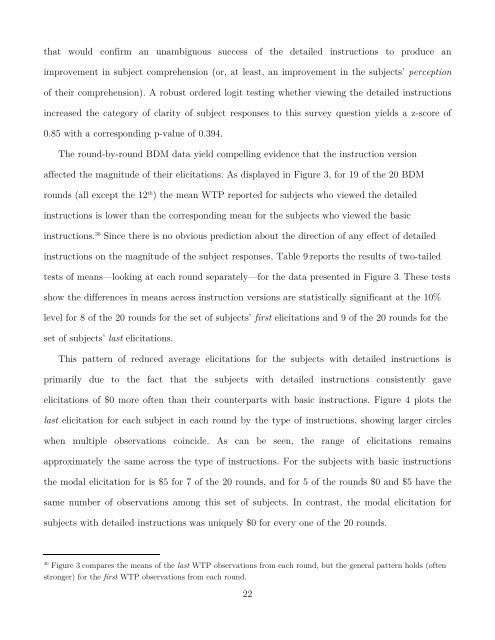Testing Distributional Dependence in the Becker-DeGroot-Marschak ...
Testing Distributional Dependence in the Becker-DeGroot-Marschak ...
Testing Distributional Dependence in the Becker-DeGroot-Marschak ...
Create successful ePaper yourself
Turn your PDF publications into a flip-book with our unique Google optimized e-Paper software.
that would confirm an unambiguous success of <strong>the</strong> detailed <strong>in</strong>structions to produce an<br />
improvement <strong>in</strong> subject comprehension (or, at least, an improvement <strong>in</strong> <strong>the</strong> subjects’ perception<br />
of <strong>the</strong>ir comprehension). A robust ordered logit test<strong>in</strong>g whe<strong>the</strong>r view<strong>in</strong>g <strong>the</strong> detailed <strong>in</strong>structions<br />
<strong>in</strong>creased <strong>the</strong> category of clarity of subject responses to this survey question yields a z-score of<br />
0.85 with a correspond<strong>in</strong>g p-value of 0.394.<br />
The round-by-round BDM data yield compell<strong>in</strong>g evidence that <strong>the</strong> <strong>in</strong>struction version<br />
affected <strong>the</strong> magnitude of <strong>the</strong>ir elicitations. As displayed <strong>in</strong> Figure 3, for 19 of <strong>the</strong> 20 BDM<br />
rounds (all except <strong>the</strong> 12 th ) <strong>the</strong> mean WTP reported for subjects who viewed <strong>the</strong> detailed<br />
<strong>in</strong>structions is lower than <strong>the</strong> correspond<strong>in</strong>g mean for <strong>the</strong> subjects who viewed <strong>the</strong> basic<br />
<strong>in</strong>structions. 30 S<strong>in</strong>ce <strong>the</strong>re is no obvious prediction about <strong>the</strong> direction of any effect of detailed<br />
<strong>in</strong>structions on <strong>the</strong> magnitude of <strong>the</strong> subject responses, Table 9 reports <strong>the</strong> results of two-tailed<br />
tests of means—look<strong>in</strong>g at each round separately—for <strong>the</strong> data presented <strong>in</strong> Figure 3. These tests<br />
show <strong>the</strong> differences <strong>in</strong> means across <strong>in</strong>struction versions are statistically significant at <strong>the</strong> 10%<br />
level for 8 of <strong>the</strong> 20 rounds for <strong>the</strong> set of subjects’ first elicitations and 9 of <strong>the</strong> 20 rounds for <strong>the</strong><br />
set of subjects’ last elicitations.<br />
This pattern of reduced average elicitations for <strong>the</strong> subjects with detailed <strong>in</strong>structions is<br />
primarily due to <strong>the</strong> fact that <strong>the</strong> subjects with detailed <strong>in</strong>structions consistently gave<br />
elicitations of $0 more often than <strong>the</strong>ir counterparts with basic <strong>in</strong>structions. Figure 4 plots <strong>the</strong><br />
last elicitation for each subject <strong>in</strong> each round by <strong>the</strong> type of <strong>in</strong>structions, show<strong>in</strong>g larger circles<br />
when multiple observations co<strong>in</strong>cide. As can be seen, <strong>the</strong> range of elicitations rema<strong>in</strong>s<br />
approximately <strong>the</strong> same across <strong>the</strong> type of <strong>in</strong>structions. For <strong>the</strong> subjects with basic <strong>in</strong>structions<br />
<strong>the</strong> modal elicitation for is $5 for 7 of <strong>the</strong> 20 rounds, and for 5 of <strong>the</strong> rounds $0 and $5 have <strong>the</strong><br />
same number of observations among this set of subjects. In contrast, <strong>the</strong> modal elicitation for<br />
subjects with detailed <strong>in</strong>structions was uniquely $0 for every one of <strong>the</strong> 20 rounds.<br />
30 Figure 3 compares <strong>the</strong> means of <strong>the</strong> last WTP observations from each round, but <strong>the</strong> general pattern holds (often<br />
stronger) for <strong>the</strong> first WTP observations from each round.<br />
22


